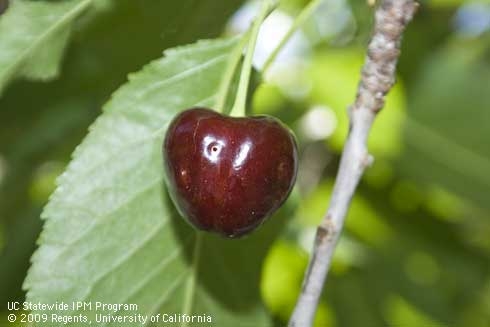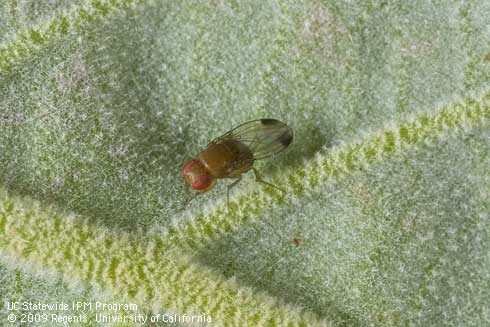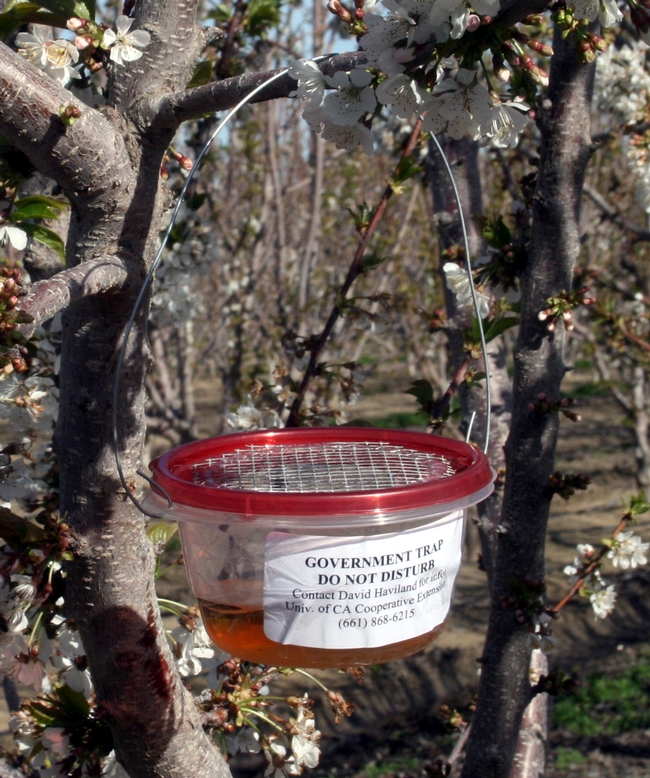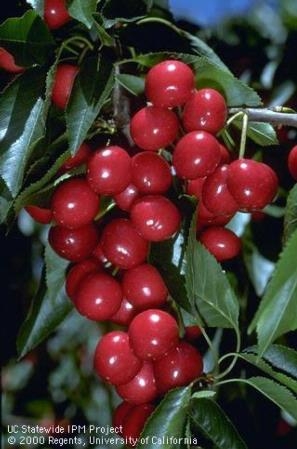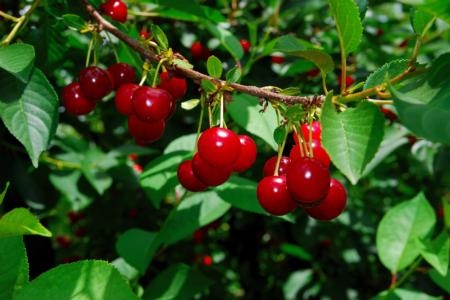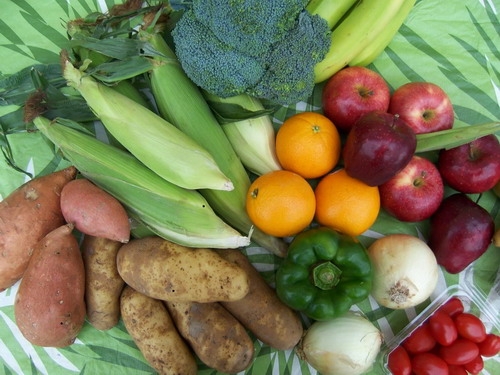Posts Tagged: cherries
Be on the lookout for spotted wing drosophila
It's cherry growing season and a good time to begin looking for spotted wing drosophila (SWD), Drosophila suzukii. SWD is a small fruit fly that attacks soft-flesh fruit such as cherry, blueberry, raspberry and blackberry. It first appeared in 2010, and its damage to fruit and increased management costs led to significant economic losses to cherry growers throughout California and the Pacific Northwest.
Unlike other fruit flies that infest rotted fruit, SWD attacks undamaged fruit. As cherry fruit begins to develop and starts to change color from light green to straw, SWD lays its eggs just under the skin of fruit, creating a small scar or a“sting.” One to three larvae may develop inside each cherry, feeding on the fruit and causing it to become brown and soft. Many times SWD flies are not noticed until fruit is mature, and by that time management is not very effective.
Spotted wing drosophila is still a relatively new pest, and management information continues to change. David Haviland, UC Cooperative Extension advisor in Kern County, and other researchers have been working to provide what help they can. Haviland has designed a bucket trap called the “Haviland trap” and is working with others to field-test experimental lures for SWD. He's also studying a possible biological control agent. Research has led to new grower guidelines so that early season cherries can be produced and sold internationally. Check out the 2014 Recommendations for Sweet Cherry (PDF).
For management in backyard cherries or other urban areas, see the SWD Pest Note.
For more information about UC IPM's recent work, see the 2013 Annual Report.
California cherry crop 'unusually light'
California cherries are now beginning to show up at roadside stands, farmers markets and grocery stores, but the supply in 2013 may be a touch scanty, reported Reed Fujii in the Stockton Record.
Joe Grant, UC Cooperative Extension advisor in San Joaquin County, said the cherry crop is light throughout the area, across orchards and varieties.
"That rules out orchard-to-orchard factors, management factors or disease factors," he said.
Crop losses are often weather-related, but early frosts, or wet or cold weather during the bloom were not factors.
"Right now, the only candidate ... is we had quite warm weather for a couple of days during bloom," Grant said. That heat may have affected pollination and reduced the amount of fruit each tree carries.
On the bright side, the fruit looks to be of good quality.
Farmers turning in greater numbers to mechanical harvesting
The dwindling supply of workers has created a new urgency for California farmers to employ mechanical harvesting technology, reported the San Luis Obispo Tribune.
Some cherry growers, for example, were able to pick only once this year, said Chuck Ingels, UC Cooperative Extension advisor in Sacramento County. Ideally, they'd pick as fruit colors and ripens.
"They're finding that if they can't get labor to pick their crops, they're just not able to farm anymore," Ingels said. "So what they're going to is mechanization."
UC Davis agriculture experts, farmers and industry leaders gathered last month in Orland to watch a demonstration of the first mechanical harvest of Manzanilla table olives in California. The new technology could revive the industry, the article said.
Even pear harvesting, a grueling job that requires workers to climb aluminum ladders with heavy bags of fruit, may be ripe for new harvest technology. For apples and pears, there are platforms for workers to stand on that move through the orchard while the workers feed the fruit into flexible tubes, where suction carries the fruit to bins.
"It's definitely on the radar for growers in the industry," Ingels said.
Reasons for the seasons
California residents not only enjoy an enviable climate and diverse regions, but also a wide selection of fresh produce year around.
As consumers, we want to stretch our food budget and provide a nutritious diet to our families; but we are not always sure about how to select the best fruits and vegetables, how to store them when we get home, new ways to serve them, and the nutrition benefits they offer.
Placer-Nevada Cooperative Extension has come to the rescue! As part of the Nutrition Best program, UCCE nutrition educators have prepared "Reasons for the Seasons - Produce tips for Placer County consumers," a series of seasonal produce handouts that provide practical information for families and children on purchasing, storing, preparing and serving locally grown seasonal produce.
Each handout also includes tips for families on the importance of family meals and snacks, a couple of tasty and easy-to-prepare recipes, and a coloring page for the children.
News & Information Outreach in Spanish has started to adapt into Spanish these handouts, and produced short video clips. The first one is for strawberries.
To tickle your interest, here is a sampling of some of the tips and information you'll find:
Apples – Over 7,000 varieties have been identified, however most consumers are only familiar with half a dozen or so varieties. Munching on an apple is a tooth cleaner and a gum stimulator. Apples may last up to three months if stored correctly.
Broccoli – Its name comes from the Latin word Brachium which means "branch" or "arm." Broccoli is one of the most nutritious vegetables you can eat. Instead of loading it with a cream sauce that is high in fat, try serving it with silvered almonds, sesame seeds, toasted bread crumbs or parmesan cheese. The leaves can also be eaten and contain more beta carotene than the florets. Store broccoli in an open plastic bag in the refrigerator vegetable drawer. For boiling or steaming, use a non-aluminum pot or pan. Aluminum seems to increase broccoli's cooking odors.
Cherries – Cherries are among the best foods for a snack. The riper the cherry, the larger the size, the deeper the color and the sweeter the fruit. Sour cherries are lower in calories and higher in vitamin C and beta carotene than sweet cherries. You can extend the cherry season by freezing them. They will keep for up to a year in your freezer.
Tomatoes - Botanically, tomatoes are a fruit. This is because, generally, a fruit is the edible part of the plant that contains the seeds, while a vegetable is the edible stems, leaves and roots of the plants. Tomatoes are the leading source of vitamin C in the American diet because of the quantities we eat. Store tomatoes at room temperature for up to one week; longer if still ripening.
Potatoes - Keep the potatoes in a burlap or a brown paper bag. Do not store onions with potatoes. The gases given off by onions accelerate the decay of potatoes and vice versa.
Melons – Most melons originated in the Near East. They are a good source of vitamin A, C and potassium. Serve melons slightly chilled; if they are too cold, you'll miss their full fragrance. Ripe melons are very fragrant, and the aroma of a cut melon can penetrate and effect other foods
Cauliflower – A good source of vitamin C, potassium and fiber. It has been associated with reducing the risk of cancer. Cauliflower should not be cooked in an aluminum or iron pot. It will turn yellow if cooked in an aluminum pot, and blue-green or brown if cooked in an iron pot.
Beets – Beets come in a glistening array of color, from garnet red, to red-white striped, to deep gold, to creamy white. The entire beet, from its robust and flavorful root to its buttery green top, is sweet and delicious. To maintain firmness, cut off beet greens before storing, but leave at least an inch of the stem attached.
May and June are cherry season, so why not look for new ways to enjoy this delicious and nutritious fruit?
Cherry salsa
1/4 cup dried cherries, coarsely chopped
1- 1/3 cups tart cherries, frozen
1/4 cup red onion, finely chopped
1 tablespoon jalapeños, diced
1 clove garlic, peeled and chopped
1 tablespoon fresh cilantro, chopped
1 teaspoon cornstarch
Coarsely chop cherries. Let cherries thaw and drain, reserving 1 tablespoon cherry juice. When cherries are thawed, combine drained cherries dried cherries, onion, jalapenos, garlic, and cilantro in a medium saucepan; mix well. Combine reserved cherry juice and cornstarch in a small bowl; mix until smooth. Stir into cherry mixture. Cook, stirring constantly, over medium-high heat until mixture is thickened. Let cool. Serve with tortilla chips.
This recipe can also be served over cooked chicken or pork
Southwestern-style cherry slaw
Yield: 6 -8 servings
Slaw:
4 cups shredded green cabbage
3 cups sweet cherries, pitted and halved
2 cups torn fresh spinach leaves
1 cup shredded jicama (optional)
1 cup shredded carrot
1/2 cup snipped fresh cilantro
1/2 cup diced red onion
1 avocado, peeled and diced
Toasted pine nuts for garnish
Dressing:
2 tablespoons olive oil
2 tablespoons fresh lime juice
2 tablespoons frozen lime juice concentrate, thawed
1 jalapeno pepper, seeded and minced
1/2 teaspoon lime zest
1/4 teaspoon each chili powder, ground cumin and salt
In large serving bowl, combine ingredients for Slaw. In small saucepan, combine Dressing ingredients; heat to boil. Pour over salad and toss gently to coat. Garnish with pine nuts and serve.
Recipe: Northwest Cherries Online
Bellydancing with your blueberries?
How about looking at Saturn through a telescope, picking your own cherries and blueberries, learning from UC Merced scientists how they estimate snow pack and water flow, taking a dip in the river, tasting local olive oil, wine and cheese, painting a picture, petting a lamb, and camping out in the walnut orchard? About 600 people enjoyed all this and more at the Pick and Gather Festival at Riverdance Farm in Merced County June 5 and 6.
Organic farmers Cindy Lashbrook and Bill Thomson, owners of the 70-acre diversified Riverdance Farm, host this annual event the weekend after Memorial Day. Lashbrook and Thomson are among the growing number of small and mid-scale California farmers and ranchers who open their farm gates to the public for enjoyment and education, helping to build community and connection between the 98 percent of Californians who do not work in agriculture and the 2 percent who do.
The Pick and Gather this year was a mellow family-friendly event with bands, folk-singers and belly-dancers entertaining the crowd. Informational booths, staffed by the UC Cooperative Extension Master Gardeners, the WIC program, Valley Land Alliance, the Merced Farm Bureau and other local groups, were very popular. Local farms offered honey, jams, lemonade, olive oil and other goodies in a shady general store, and there was plenty of room to sit and enjoy lunch prepared by vendors or to eat picnics brought from home. Delicious ripe U-pick organic cherries and blueberries were at wholesale prices. With unemployment in Merced County at about 20 percent this year, Lashbrook and Thomson keep the admission price low and make sure to offer lots of free children’s activities, including art and a petting zoo, and of course, the river to play in.
Riverdance Farm itself, like many farms its size, is having a difficult time staying in business by simply selling crops.The owners would like to see their festival be part of helping sustain the farm financially without losing its friendly community feeling. Most of the visitors were not aware of the costs involved in putting on a festival, from the insurance to the health permit fees to the renting of the water-truck and the porta-potties, not to mention the cost of the farmers’ time away from the work of farming. Lashbrook estimates that it would take another few hundred visitors and maybe some more sponsors and paying vendors to turn the Pick and Gather into an income-generating venture.
The UC Small Farm Program’s agritourism project works to help agritourism operators plan successful and profitable agritourism enterprises on their working farms and ranches, and also to help visitors find festivals and other agritourism activities on working farms and ranches. The Small Farm Program website has a wealth of resources for growers evaluating their own potential for agritourism operations and navigating the risk management, business planning, permitting and promotional aspects of the new businesses.
Agritourism is blossoming in California, with farm tours, classes, farm stays, U-pick operations, farm stands and festivals in almost every county. Potential visitors can find a farm or ranch to visit and check the calendar for events at www.calagtour.org, the University of California’s agritourism directory. Farmers and ranchers are invited to list their agritourism operations and events on the site for no charge.

Riverdance general store

Valley Land Alliance booth

A dip in the Merced River
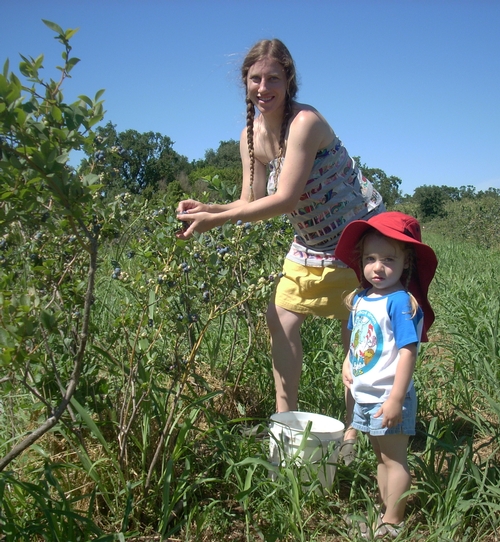
Blueberry pickers

